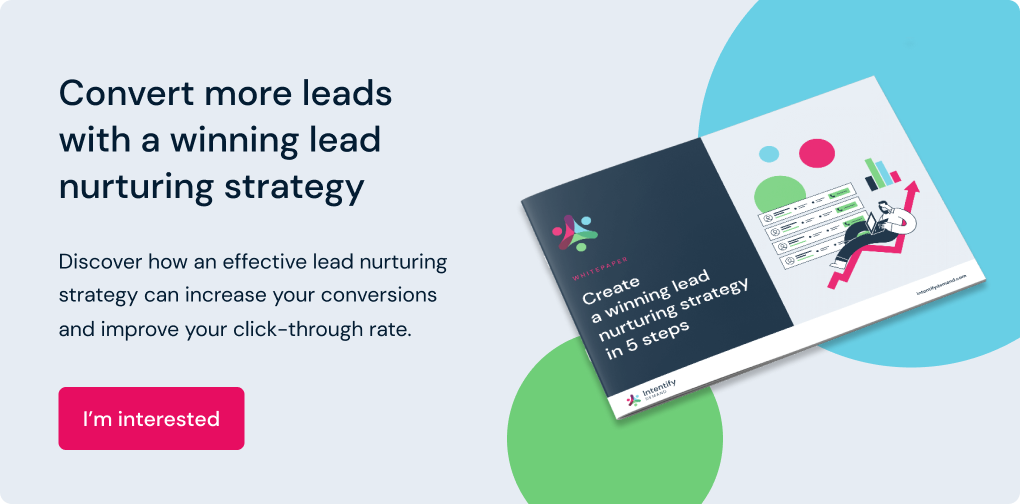Read time: 7 minutes
A good lead generation campaign allows you to personalise your marketing efforts, identify the highest-quality prospects and build your email list.
And, of course, it allows you to populate your sales pipeline with quality leads. In fact, according to Intellistart, companies with a mature lead generation strategy see an average of 133% increase in revenue.
But no matter how skilled a marketer you are or how long you’ve been in the industry, there are some common campaign challenges that continue to crop up. These can be frustrating and let’s face it, a little deflating.
The good news is that they're easy to fix, so you can focus your efforts on attracting and capturing the interest of potential customers and generating valuable leads.
1. You don't have a clear target audience
Generating generic campaigns in a bid to target as many people as possible can feel like shouting into the void. You know there are a lot of people out there, but no one is listening.
When it comes to lead generation, finding and targeting the right audience is a big challenge. But without targeted campaigns and high-quality traffic, you’ll struggle to generate qualified leads.
How to fix it: build an ABM list
Start by compiling data on your current customers, looking at the key demographics, buying habits and where they engage with your brand. You can then begin to assess your audience, defining who they are, their pain points and how you can address their problems.
If you haven’t done so already, create a detailed ideal customer profile (ICP) to help keep your target audience at the forefront of all future marketing efforts.
Recommended reading: How to build an ideal customer profile for better lead gen results
Working with intent data, you can then build an ABM list based on account purchase intent. This powerful, focused approach will help you to pursue more meaningful opportunities; targeting specific, high-value prospects.
Plus, this list can serve as a guide for your marketing team, allowing you to prioritise who you target, when and where. This information can have a huge impact on your lead generation campaigns and how successful they are in the future.
2. Prospects aren’t showing enough interest
You've invested a lot of time and resources into creating what you believe to be an engaging lead generation campaign, yet your prospects just don’t seem to be showing much interest.
It’s confusing and disheartening, but there is a simple solution: you need to stop using a one-size-fits-all approach.
How to fix it: tailor your marketing strategies to different buyer personas
You need to tailor your marketing efforts and use personalisation to meet the specific needs and interests of your target audience. This makes your campaigns more likely to attract high-quality leads who are truly interested in your products or solutions.
Knowing your target audience is only the first step, as every lead is different. This could be a result of a number of factors, including company size, number of people involved in the decision making process, seniority, and buying cycle. So it's important to create buyer personas that identify different types of buyers, their unique needs and interests and their buying patterns.
Creating buyer personas for your target audience enables you to take a more personalised approach which fosters a stronger connection with your audience and a more memorable experience.
This can be achieved through personalised email campaigns, targeted landing pages, carefully crafted blog content or one-to-one communication. Whatever your preferred method, it’s about tailoring your campaigns to build trust and credibility.
Layering intent data over the top also means you're able to deliver the most relevant content at the right time, based on an individual's purchase intent and online behaviour. You can segment your audience and create custom nurture workflows based on how they interact with your brand while also gaining better insight into when they're likely to make a purchase.
3. Your content isn't delivering results
Engaging, relevant content can be a valuable resource, with 85% of B2B marketers (and 60% of B2C marketers) saying they use content to generate leads.
But when you're creating and sharing content that seems to go largely ignored, it can feel like a huge waste of time.
Not to mention that if your content isn’t gaining traction and generating leads, you're missing out on a huge opportunity.
How to fix it: create content for different buying stages
In order to create meaningful content, you need to think about how it can help your target audience.
It’s crucial that you’re always addressing their pain points and engaging them with information they find genuinely interesting and useful. Whatever form your content takes, whether that's downloadable whitepapers and ebooks, webinars, podcasts, or infographics, you need a healthy mix that serves every stage of the marketing funnel. This means it can't always be sales-focused as this only appeals to those much further down the funnel and won't work well in attracting potential new leads.
Instead, think about how you can offer value to those who are at the top of the funnel or researching solutions for particular challenges.
This will help you capture the attention of your target audience. And those who consume and appreciate your content are more likely to become a prospective customer, completing desired actions like signing up for your newsletter.
4. There's no follow-up activity from warm leads
You’ve obtained quality leads and they seem to show a genuine interest in your brand in the early stages, but they're still not converting. They start off interacting with a lot of your content but suddenly go quiet and are never heard from again.
If this sounds familiar, it’s likely that you don’t have a strong lead nurture strategy in place and that these prospects are simply losing interest before they make it to the next stage of the sales funnel.
How to fix it: nurture, nurture, nurture
The lead generation process doesn't end once you’ve got their details. You need to make sure that you're nurturing these leads and keeping them engaged.
Which, in turn, helps you to guide them through the sales funnel.
Creating a great campaign starts with aligning it closely with your Ideal Customer Profile (ICP), ensuring that your messaging resonates deeply with your target audience's needs and interests. Nurturing those leads can lead to gratifying results, build connections and drive continuous business expansion.
- Katerina Charamlambous, Head of Campaigns
Your lead nurturing strategy should also focus on personalisation, as well as sharing great content. This must be timely and pertinent in order to engage or re-engage leads.
You should also take a modern, multi-channel approach. Exploding Topics revealed that 97% of people will ignore cold calls and only around 1 in 5 marketing emails are opened. So it’s not enough to rely on these more traditional methods alone.
Marketing automation tools have made it possible to implement multi-channel lead nurturing strategies that use a combination of email, paid retargeting, dynamic web content and social media. In fact, for over two-thirds (68%) of marketers, social media marketing has helped them generate more leads.
So it’s important to use personalisation, segmentation and key insights to successfully nurture more of these B2B leads, ensuring that your brand stays fresh in their mind and that you continue to build on the relationship.
5. Your lead generation campaigns are time consuming and you don't have enough visibility
While lead generation is a key objective for any business, the problem is that it can be a challenging and time-consuming part of an already vast and complex marketing strategy.
Designing, creating and implementing the right campaigns doesn't happen overnight. And on top of that, you have to continue nurturing these leads once they show interest.
It can feel like a never-ending task, and when it’s not your only marketing responsibility, it can feel quite overwhelming.
How to fix it: work with the right lead generation tools and vendors
The best way to tackle this challenge is to ensure you have the right lead generation tools in place to tackle and automate these time-consuming activities.
From AI and automation to social media scheduling, there are loads of great providers out there that can help make your lead generation campaigns simpler.
For example, you can use these tools to segment your data, track a prospect’s activity online, build ABM lists, deliver personalised content and so much more. Additionally, working with a trusted lead generation partner could help to alleviate the strain on your marketing team. Not only does this save you time, but it also gives you access to premium tools such as predictive analytics and first-party intent data which can help generate better quality leads that are more likely to convert.
Lead generation + intent data = a match made in heaven
There's a lot to consider when it comes to lead generation and as customer expectations shift, it's on marketers to keep up, be competitive and deliver tailored campaigns. This is becoming increasingly difficult when leveraging older, more static forms of market research.
Intent data has undeniably changed the face of marketing. It's providing fresh, actionable insights and taking the guesswork out of marketing campaigns. Not only does this create a smoother, more enjoyable customer journey, but it also increases the ROI of lead generation efforts.
Data-driven marketing is a powerful tool, and it's here to stay. So the only way marketers can make the most of it is to embrace it in their strategy and use it to fuel their growth.





